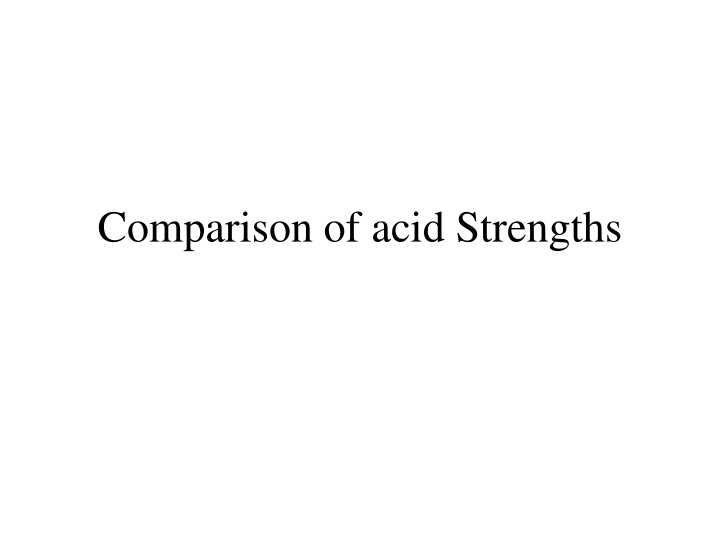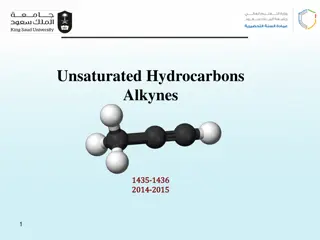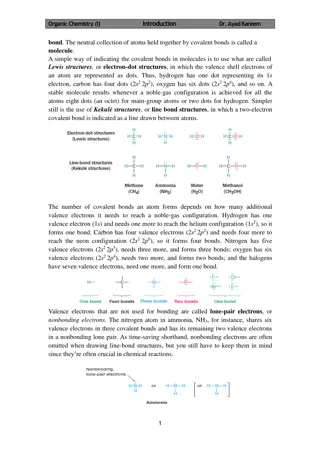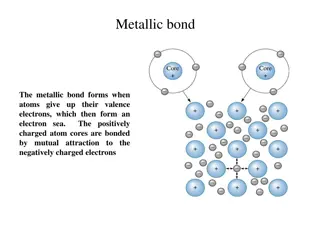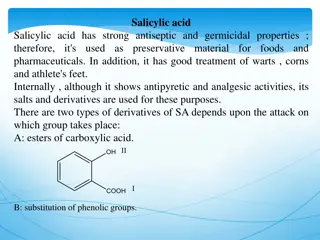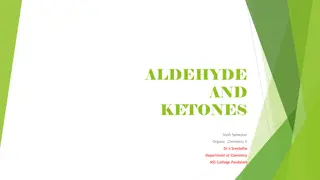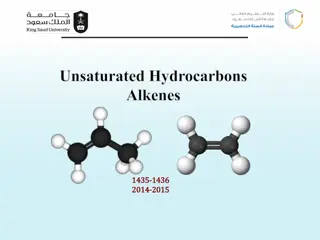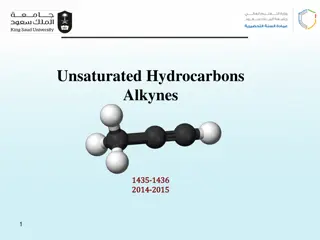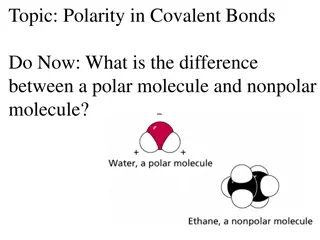Factors Affecting Acid Strength: Atoms, Size, Hybridization, and Electronegativity
The strength of acids is influenced by various factors such as the atom on which the negative charge of the acid's conjugate base rests, atom size, hybridization, and electronegativity. The stability of negative charges on atoms, atom size allowing charge delocalization, preferred orbital types for lone-pair anions, and the impact of electron-withdrawing groups on acidity are all crucial in determining acid strength.
Download Presentation

Please find below an Image/Link to download the presentation.
The content on the website is provided AS IS for your information and personal use only. It may not be sold, licensed, or shared on other websites without obtaining consent from the author.If you encounter any issues during the download, it is possible that the publisher has removed the file from their server.
You are allowed to download the files provided on this website for personal or commercial use, subject to the condition that they are used lawfully. All files are the property of their respective owners.
The content on the website is provided AS IS for your information and personal use only. It may not be sold, licensed, or shared on other websites without obtaining consent from the author.
E N D
Presentation Transcript
How atoms affect acid strength On which atom does the negative charge of the acid s conjugate base rest? A negative charge prefers to rest on electronegative (electron-loving) elements. Therefore, a negative charge is more stable on oxygen than it is on nitrogen; similarly, a negative charge is more stable on nitrogen than it is on carbon. For that reason, alcohols (R OH) are more acidic than amines (R NH2), which in turn are more acidic than alkanes (R CH3), as shown here. Negative charges prefer to rest on the more electronegative atoms.
The size of the atom also plays a role in stabilizing the negative charge. Charges prefer to be on larger atoms than on smaller atoms. This preference results from large atoms allowing the negative charge to delocalize over a much larger region of space, instead of being concentrated in a small region (as it would on a small atom). As a rule, atom size trumps electronegativity considerations. So, even though fluorine is a more electronegative atom than iodine, HI is more acidic than HF. The much larger iodine atom allows the negative charge to delocalize over a larger space than does the much smaller fluorine atom, and thus makes hydrogen iodide more acidic. The effect that atom size has on acidity is shown here.
How atom hybridization affects acid strength The orbital on which the lone-pair anion rests also affects the acidity. Lone-pair anions prefer to reside in orbitals that have more s character than p character, because s orbitals are closer to the atom s nucleus than p orbitals, and the electrons are stabilized by being closer to the nucleus. Orbitals that are sp hybridized have 50 percent s character, orbitals that are sp2hybridized have 33 percent s character, and orbitals that are sp3hybridized have 25 percent s character. Therefore, anions prefer to be in orbitals that are sp hybridized over those that are sp2hybridized orbitals, and they prefer to be in orbitals that are sp2hybridized over those that are sp3hybridized. The effect of orbital type on acidity is shown here.
. How electronegativity affects acid strength Electron-withdrawing groups on an acid also stabilize the conjugate base anion by allowing some of the charge on the anion to delocalize to other parts of the molecule. For example, trifluoroethanol (shown here) is more acidic than ethanol Electron-withdrawing groups add to a molecule s acidity by stabilizing its conjugate base anion.
The highly electronegative fluorine atoms (which are electron pigs) on trifluoroethanol pull electron density away from the anion, taking away some of the negative charge from the oxygen, thereby stabilizing the molecule. How resonance structures affect acid strength Acids with conjugate bases that allow the negative charge to be delocalized through resonance are stronger acids than acids whose conjugate bases don t have resonance structures. For example, acetic acid, shown here, is much more acidic than ethanol because the conjugate base anion of acetic acid can delocalize the negative charge through resonance.
Groups Organic Chemistry In organic chemistry, functional groups (or reactive centers) are small structural units within molecules that dictate how most of the compound s chemical reactions occur. Know these common functional groups you will run into in organic chemistry:
Five Key Factors That Affect Acidity Today we ll talk about what s behind the trends in acidity for different molecules and discuss the most important factors that determine these values. I ve written in schoolmarmish tones before about how pKa is one of the most important measures you can learn in organic chemistry, and not knowing some basic pKa values before an exam is a lot like walking up to a poker table without knowing the values of the hands: you re going to lose your shirt
Lets quickly review the basics of acidity and basicity. Heres the condensed version: 1.Bronsted acids are proton donors, Lewis acids are electron pair acceptors. Converse: Bronsted base = proton acceptor, Lewis base = electron pair donor. 2.A conjugate base is what you obtain when you remove a proton (H+) from a compound. For instance, HO is the conjugate base of water. O2-is the conjugate base of HO . Conversely, conjugate acids are what you obtain when you add a proton to a compound. The conjugate acid of water is H3O+. 3.Quick quiz: is pH 1 acidic or basic? pKa is similar to pH in that low (and even negative values) denote strong acids. That s because pKa is based on the equilibrium:
4.According to this, anything which stabilizes the conjugate base will increase the acidity. Therefore pKa is also a measure of how stable the conjugate base is. Put another way, strong acids have weak conjugate bases, and vice versa. With that out of the way, let s get started. Table of Contents 1.Factor #1 Charge. 2.Factor #2 The Role of the Atom 3.Factor #3 Resonance 4.Factor #4 Inductive effects 5.Factor #5 Orbitals
Factor #1 Charge. Removal of a proton, H+ , decreases the formal charge on an atom or molecule by one unit. This is, of course, easiest to do when an atom bears a charge of +1 in the first place, and becomes progressively more difficult as the overall charge becomes negative. The acidity trends reflect this Note that once a conjugate base (B-) is negative, a second deprotonation will make the dianion (B 2-). While far from impossible, forming the dianion can be difficult due to the buildup of negative charge and the corresponding electronic repulsions that result.
2. Factor #2 The Role of the Atom This point causes a lot of confusion due to the presence of two seemingly conflicting trends. Here s the first point: acidity increases as we go across a row in the periodic table. This makes sense, right? It makes sense that HF is more electronegative than H2O, NH3, and CH4 due to the greater electronegativity of fluorine versus oxygen, nitrogen, and carbon. A fluorine bearing a negative charge is a happy fluorine. But here s the seemingly strange thing. HF itself is not a strong acid, at least not in the sense that it ionizes completely in water. HF is a weaker acid than HCl, HBr, and HI. What s going on here?
You could make two arguments for why this is. The first reason has to do with the shorter (and stronger) H-F bond as compared to the larger hydrogen halides. The second has to do with the stability of the conjugate base. The fluoride anion, F( ) is a tiny and vicious little beast, with the smallest ionic radius of any other ion bearing a single negative charge. Its charge is therefore spread over a smaller volume than those of the larger halides, which is energetically unfavorable: for one thing, F( ) begs for solvation, which will lead to a lower entropy term in the G. Note that this trend also holds for H2O and H2S, with H2S being about 10 million times more acidic.
Factor #3 Resonance A huge stabilizing factor for a conjugate base is if the negative charge can be delocalized through resonance. The classic examples are with phenol (C6H5OH) which is about a million times more acidic than water, and with acetic acid (pKa of ~5).
Predictably, this effect is going to be related to two major factors: 1) the electronegativity of the element (the more electronegative, the more acidic) and the distance between the electronegative element and the negative charge. 5. Factor #5 Orbitals Again, the acidity relates nicely to the stability of the conjugate base. And the stability of the conjugate base depends on how well it can accomodate its newfound pair of electrons. In an effect akin to electronegativity, the more s character in the orbital, the closer the electrons will be to the nucleus, and the lower in energy (= stable! ) they will be.
